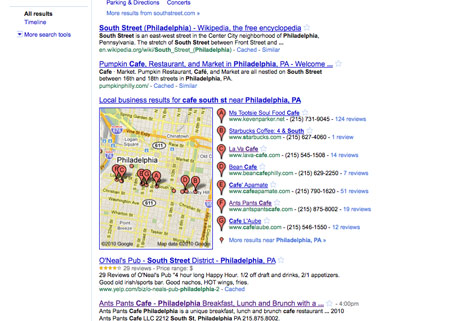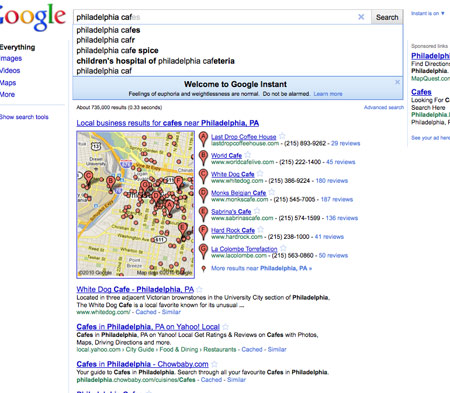Today Google rolled out their Google Instant Search results which, in a nutshell, reveals more search results based on every letter you type into their search box. This realtime stream of results yields a flurry of activity on the page below while you busily type your search term. Users have to be logged in to get this so it’s most likely based on your search history as much as their data. I thought I would hate it but I don’t. In fact I like it enough to switch regularly from using my toolbar to search when appropriate. With significant adoption, it’s going to affect client search data but as a user, it’s a nicer way to search.
What does this mean for searchers? As you type and scan it becomes more and more obvious that you have found what you are looking for, saving 2-5 seconds per search according to Google research. No longer will you have to stop at “Philadelphia Cafe” which gives you results from all over Philly:
but may want to continue on to “Philadelphia Cafe South St” to find a potential destination without having to leave the comfort of your search box.

What does this mean for SEO’s? Essentially the technology remains the same so we’re planning to continue doing what we do. With increased adoption, it does seem like there may be some interesting analytics data to crunch and I’m wondering if this will impact the long-tail rather than the head phrases but I’m leaning towards the latter in this case. There are some that are going in the other direction.
It’s really this sort of innovation that keeps Google forging ahead in their space and something that Yahoo could have utlized when they had the chance (although they never did really improve their poor search relevancy). It certainly won’t kill the SEO and it’s uncertain as to whether or not users will accept it across the board but for those who use search a lot, there’s no doubt that Instant will bring about significant productivity improvements.


